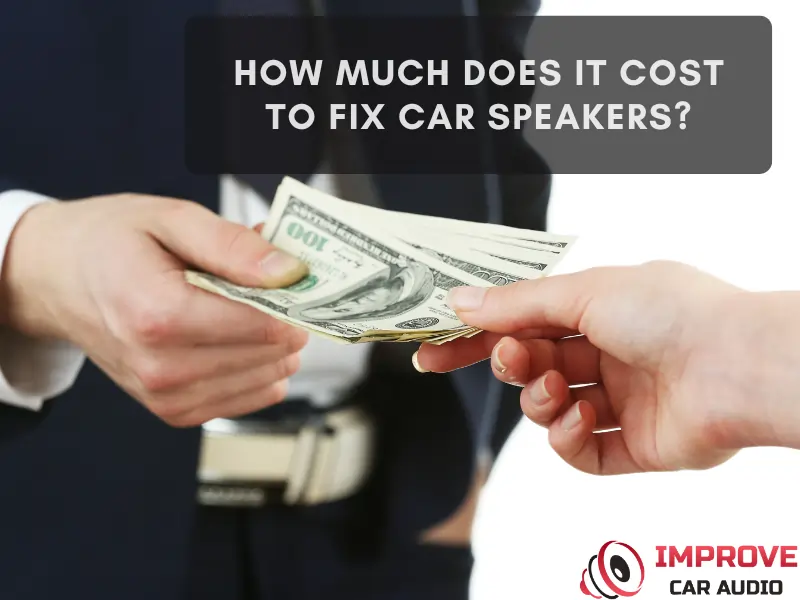How Much Does It Cost To Fix Car Speakers

The open road, wind in your hair (or blowing through your perfectly adjusted climate control vents), and the perfect soundtrack filling the cabin. For generations, the in-car audio experience has been a crucial part of the driving experience. But what happens when the music stops, or more accurately, starts crackling, distorting, or just plain disappearing? Let's delve into the question: How much does it really cost to fix car speakers, and how is the future of automotive audio reshaping this equation?
The Present: A Symphony of Complexity and Costs
The cost to fix car speakers today is anything but simple. Several factors come into play:
- The Problem: Is it a blown speaker, a wiring issue, a problem with the head unit, or even the amplifier? A simple blown speaker is the most straightforward fix.
- The Car: A basic sedan from 2010 will likely have a simpler (and cheaper) audio system than a luxury SUV with a premium branded setup like Bose, Harman Kardon, or Bang & Olufsen. These premium systems often feature proprietary components and require specialized repair or replacement parts.
- DIY vs. Professional: Attempting a DIY repair can save money, but risks causing further damage, especially with integrated systems. Professional installation guarantees proper wiring, component matching, and often includes a warranty.
- Parts Availability: Older or rare vehicles might require sourcing hard-to-find replacement speakers, driving up the cost significantly. Aftermarket options offer alternatives, but compatibility and sound quality can vary.
Currently, a single speaker replacement can range from $50 for a basic aftermarket speaker and DIY installation, to upwards of $300+ for a premium branded replacement installed by a professional. More complex issues, like amplifier failures or wiring harness problems, can easily push repair costs into the hundreds, even thousands, of dollars.
The Future is Electric, Connected, and Acoustically Advanced
The automotive landscape is undergoing a dramatic transformation, and the future of in-car audio is inextricably linked to this evolution. Here's how upcoming technologies are changing the game:
- Electric Vehicles (EVs): The inherently quieter nature of EVs is placing greater emphasis on audio quality. With engine noise gone, subtle imperfections in the sound system become much more noticeable. Expect even greater investment in noise cancellation technology and higher-fidelity audio systems. The challenge lies in optimizing sound quality while minimizing energy consumption, as premium audio systems can draw a significant amount of power.
- Hybrid Systems: While not as silent as EVs, hybrid vehicles also benefit from improved sound systems. Moreover, with more electronic components, there's increased opportunity for interference and complexity. Repairing hybrid car sound systems may be a little bit more expensive.
- Advanced Driver-Assistance Systems (ADAS): As vehicles become more autonomous, the role of in-car audio will evolve beyond entertainment. Sound will be used for critical alerts, navigation cues, and even haptic feedback, creating a more immersive and informative driving experience. Imagine directional audio alerts warning you of an approaching vehicle in your blind spot, or subtly guiding you along your route.
- Software-Defined Audio: Cars are becoming rolling computers, and audio systems are no exception. Software-defined audio allows for greater customization, over-the-air updates, and integration with other vehicle systems. This opens the door for personalized sound profiles, adaptive audio adjustments based on driving conditions, and even AI-powered sound enhancement. However, this increased complexity also means more potential points of failure and potentially more complex (and costly) repairs.
- Spatial Audio and Immersive Soundscapes: Expect to see a greater adoption of spatial audio technologies that create a more realistic and immersive listening experience. This involves strategically placing speakers throughout the cabin and using advanced signal processing to simulate a three-dimensional sound field.
However, there are challenges. The increased integration of audio systems with other vehicle functions means that diagnosing and repairing issues will require specialized expertise. Independent repair shops may struggle to keep up with the rapid pace of technological advancements, potentially driving more customers towards dealerships for audio repairs.
The Cost Equation: A Shifting Landscape
While the cost of basic speaker replacement may remain relatively stable, the complexity and integration of future audio systems suggest that repairing these systems will likely become more expensive. Specialized diagnostic tools, proprietary software, and the need for highly skilled technicians will all contribute to higher labor costs. Moreover, the increased reliance on software means that software glitches could lead to audio problems, requiring specialized software updates or even module replacements.
However, there's also reason for optimism. As technology matures, standardized components and open-source software could potentially drive down costs. The rise of 3D printing could also make it easier and cheaper to produce replacement parts for older or rare vehicles. Furthermore, the increasing availability of online resources and DIY guides could empower more car owners to tackle simple audio repairs themselves.
In Conclusion: The question of "How much does it cost to fix car speakers?" is evolving. While basic repairs might remain affordable, the future of automotive audio is heading toward increasingly sophisticated and integrated systems. The key is to embrace this evolution by staying informed, seeking out qualified technicians, and understanding the complexities of modern in-car audio technology. Ultimately, the goal is to ensure that the perfect soundtrack continues to accompany us on our journeys, no matter how the landscape of mobility changes.
The future of mobility isn't just about getting from point A to point B; it's about the experiences we have along the way. And for many, the in-car audio experience is an integral part of that journey. As we move towards a more connected, autonomous, and electric future, let's ensure that the symphony of the road continues to resonate, loud and clear.
